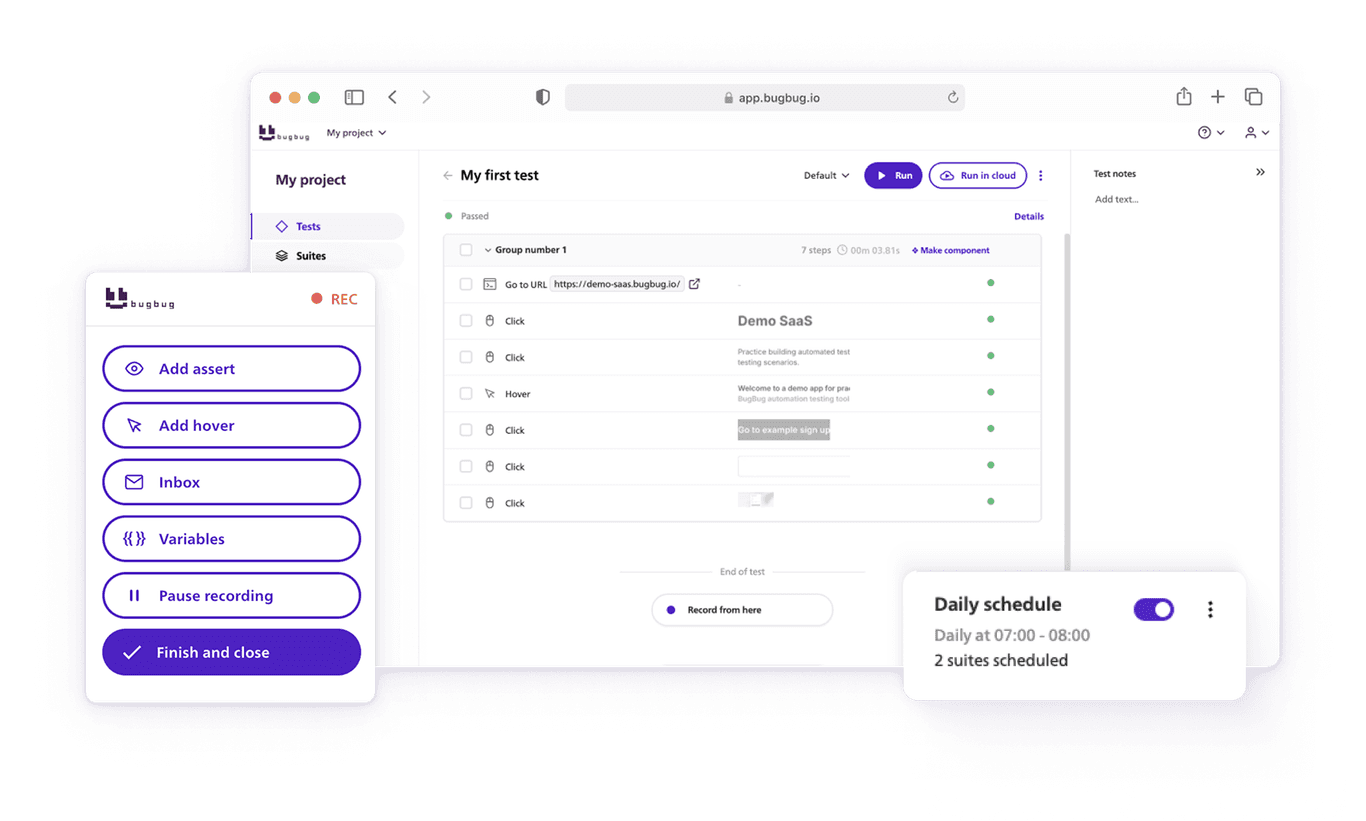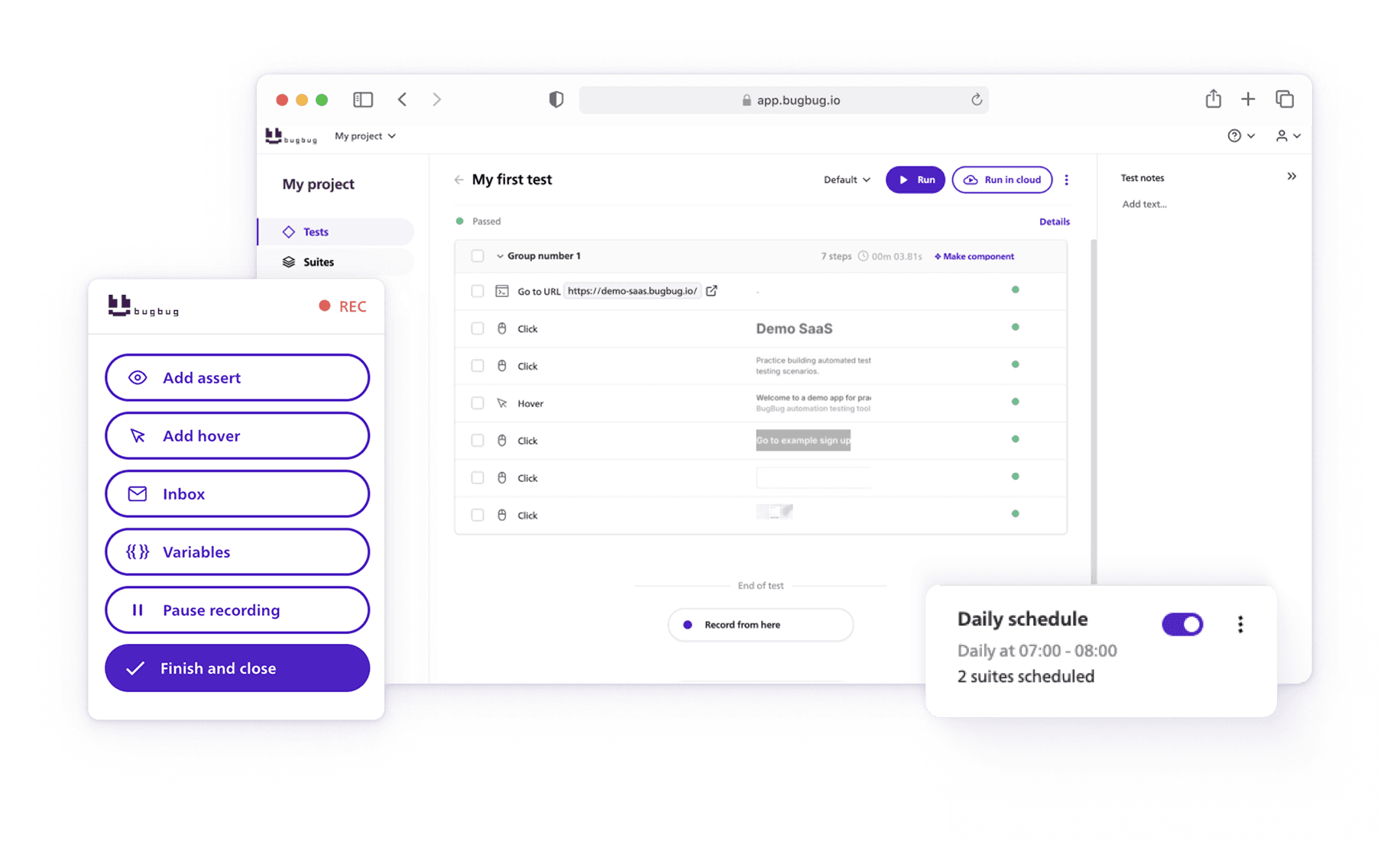🤖 Summarize this article with AI:
💬 ChatGPT 🔍 Perplexity 💥 Claude 🐦 Grok 🔮 Google AI Mode
Every team wants reliable software without burning through their QA budget. But in 2025, achieving truly affordable testing has become more complicated than ever.
- Is Affordable Testing Possible?
- Why “Affordable Testing” Is Harder Than It Sounds
- What Drives QA Testing Costs?
- Fixed vs Variable Pricing — What’s the Difference?
- The Hidden Costs of Variable Pricing
- Why Predictability Wins: The Case for Fixed Pricing
- How BugBug Keeps QA Testing Affordable
- Which Pricing Model Fits Your Team Best?
- Conclusion: Affordable QA Testing Starts with Cost Clarity
Is Affordable Testing Possible?
Automation is no longer optional — yet every test you add increases tool usage, infrastructure time, and maintenance effort. Many teams discover too late that their “cheap” QA platform comes with variable costs that scale faster than their app’s user base.
Check also:
Why “Affordable Testing” Is Harder Than It Sounds
For financial decision-makers, this unpredictability is a nightmare. One sprint runs more tests than usual, and suddenly the monthly bill doubles. Another tool starts charging extra for parallel runs. You end up spending more time explaining costs than analyzing quality metrics.
That’s why understanding how testing platforms price their services is more than an accounting exercise — it’s a strategic decision that can define whether your QA process scales efficiently or spirals into cost chaos.
This article breaks down the two dominant pricing models — fixed vs variable — and shows how to choose the most cost-effective testing approach for your organization. We’ll also explore how BugBug’s predictable pricing model helps you plan ahead, keeping your QA efforts sustainable and scalable.
What Drives QA Testing Costs?
Before comparing pricing models, let’s look under the hood. What actually makes testing expensive — and which of those costs can you control?
In most QA budgets, costs fall into five main categories:
1. Test Execution Time
Many tools charge by the minute or by the number of test runs. As your CI/CD pipeline grows, these micro-costs quickly snowball.
2. Infrastructure and Environments
Cloud-based labs, parallel browsers, and virtual machines aren’t free. Even with shared services, usage spikes can trigger overage fees.
3. Licensing and Seats
Traditional enterprise tools often charge per user, limiting collaboration or making scaling painful.
4. Test Maintenance
Flaky tests or UI changes can eat up QA hours — especially if your tool lacks editing and debugging features.
5. Integration Overheads
Complex setups require ongoing dev time for updates and troubleshooting, which translates directly into cost.
Here’s where many companies go wrong: they treat these as fixed expenses, when in reality, most are variable and usage-driven.
That means your costs rise the moment your testing frequency does — even if your quality doesn’t.
Understanding this dynamic is the first step toward achieving affordable testing that doesn’t sacrifice reliability.
Choose codeless automation with BugBug
Test easier than ever with BugBug test recorder. Faster than coding. Free forever.
Sign up for free
Fixed vs Variable Pricing — What’s the Difference?
When evaluating QA platforms, you’ll quickly encounter two main pricing philosophies: fixed pricing and variable pricing.
Both can make sense depending on your goals — but they create very different financial realities.
Fixed Pricing: Predictability Above All
A fixed pricing model means you pay a set fee, typically per month or per year, regardless of how many tests you run.
It’s like an unlimited data plan: you know exactly what your bill will be, no matter how often your pipeline executes tests.
Pros:
- Predictable monthly cost that simplifies budgeting
- Ideal for teams running regular test cycles or CI/CD integrations
- Encourages frequent testing without fear of extra charges
Cons:
- Might feel more expensive up front for teams that test infrequently
- Some vendors limit features or concurrency within fixed tiers
Variable Pricing: Pay for What You Use — But Beware
A variable pricing model bills based on usage — usually per test run, test minute, or virtual machine hour.
It sounds fair and flexible, but it also turns your QA cost into a moving target.
Pros:
- Good for short-term projects or unpredictable workloads
- Pay only when you run tests
Cons:
- Budgeting is harder because test volume fluctuates
- Bills spike when you scale automation or increase test frequency
- Discourages exploratory testing and CI/CD adoption due to cost anxiety
Comparison Table
| Factor | Fixed Pricing | Variable Pricing |
|---|---|---|
| Predictability | ✅ High | ❌ Low |
| Scalability | Medium | High (but expensive) |
| Budgeting Risk | Low | High |
| Best For | Growing QA teams, startups, CI/CD-heavy pipelines | Enterprises or short-term QA projects |
👉 Bottom line: if your team automates regularly, fixed pricing wins. It rewards consistency and supports a true continuous testing culture — the foundation of long-term affordable testing.
The Hidden Costs of Variable Pricing
At first glance, variable pricing looks attractive. “We’ll only pay for what we use” sounds efficient — until you start scaling.
That’s when the fine print comes to life.
The Test Volume Trap
A growing product means more regression cycles, more browsers, and more test data. Suddenly your “per-run” billing grows 10× — even though your app hasn’t changed much.
Example: a small SaaS team running daily smoke tests finds its monthly bill jumping from $90 to $450 just by adding nightly builds.
Parallel Execution Fees
To save time, you’ll want to run tests in parallel. Many vendors charge extra per parallel session, turning a time-saving feature into a hidden cost center.
Idle Usage Overhead
Even unused cloud environments can count as “active time.” That means you’re billed while your test suite is waiting for data, loading dependencies, or retrying flaky steps.
The Growth Penalty
Ironically, the more you embrace automation, the more you pay. Instead of rewarding efficiency, variable pricing punishes teams for scaling quality.
That’s why so many teams end up throttling their own testing to stay within budget — a terrible trade-off between cost control and product confidence.
Why Predictability Wins: The Case for Fixed Pricing
The biggest advantage of fixed pricing isn’t just saving a few dollars — it’s control.
When you know your QA costs up front, your team can plan, scale, and test freely. No guesswork. No explaining why a single sprint cost three times more than the last.
Freedom to Test Without Fear
Fixed-cost models encourage healthy testing habits.
Teams can rerun regression tests, experiment with edge cases, and integrate testing deeply into CI/CD pipelines — without worrying about usage caps or per-minute billing.
By contrast, teams using variable models often limit themselves. They test less often or skip full-suite runs to stay under budget.
That short-term saving often translates into long-term risk: production bugs, slower releases, and eroded customer trust.
Fixed Pricing with BugBug
Test easier than ever with BugBug test recorder. Faster than coding. Free forever.
Sign up for free
Case Example: How Predictability Scales Confidence
A SaaS startup automating its release cycles moved from a pay-per-run testing platform to a fixed-cost one.
After the switch, their QA cadence doubled — and their costs stabilized. Developers no longer checked pricing before hitting “Run.”
Predictability made testing an integral part of their delivery pipeline, not an expense to monitor.
Bottom line: predictability in QA is more than financial convenience — it’s an enabler of software quality.
How BugBug Keeps QA Testing Affordable
Many testing tools claim to be “cost-effective.”
BugBug actually makes it effortless to achieve affordable testing — by cutting out the hidden costs that creep into most automation platforms.
BugBug embodies this philosophy by offering:
- Unlimited test runs under a flat monthly rate
- Codeless automation accessible to every QA role
- Zero infrastructure overhead
- Seamless CI/CD integration without hidden costs
Which Pricing Model Fits Your Team Best?
Every QA team is different — not just in size, but in workflow rhythm, release cadence, and automation maturity.
Choosing between fixed and variable pricing isn’t about which one is “cheaper,” but which one aligns with how your team actually works.
✅ Choose Fixed Pricing If You:
- Run tests continuously (e.g., nightly or after every commit)
- Have predictable release cycles and steady testing volume
- Want clear monthly costs and budget-friendly planning
- Prefer freedom to scale automation without worrying about extra fees
Fixed pricing supports the reality of modern software development: fast iterations, frequent deployments, and continuous validation.
It ensures QA isn’t limited by cost anxiety — making your process more reliable and your planning more accurate.
⚙️ Choose Variable Pricing If You:
- Handle short-term projects with sporadic testing needs
- Have a small codebase and limited regression suites
- Only need automated tests occasionally, not as part of CI/CD
- Value low upfront costs more than long-term predictability
Variable models may make sense when you’re experimenting — but once your team scales or embraces DevOps workflows, costs can rise faster than anticipated.
💡 Quick Checklist: How to Decide
Ask yourself these five questions:
- How often do we run automated tests?
- Do our testing needs stay stable or fluctuate each month?
- Are cost spikes affecting how often we test?
- Do we need to justify QA costs to non-technical stakeholders?
- Is our goal to make testing a routine part of development?
If you answered “yes” to most of those, fixed pricing — like BugBug’s model — is almost always the better fit.
Conclusion: Affordable QA Testing Starts with Cost Clarity
Affordable testing isn’t about chasing the lowest price tag.
It’s about building a testing process that’s sustainable, predictable, and scalable — one that lets your team focus on quality, not accounting.
Fixed pricing gives you that stability.
It removes uncertainty, rewards consistency, and allows you to plan confidently — whether you’re automating your first smoke tests or managing a mature CI/CD pipeline.
So if your testing process feels unpredictable — both technically and financially — it might be time to simplify.
With BugBug, you can finally make affordable testing part of your QA strategy, not just your budget spreadsheet.



